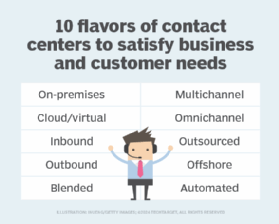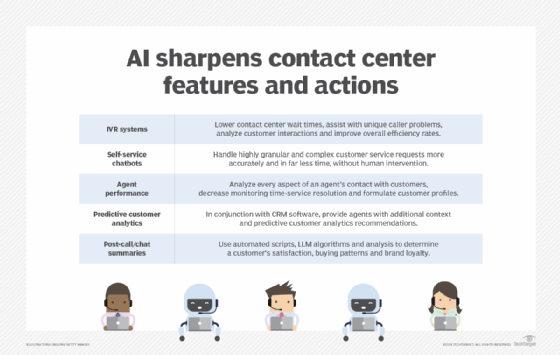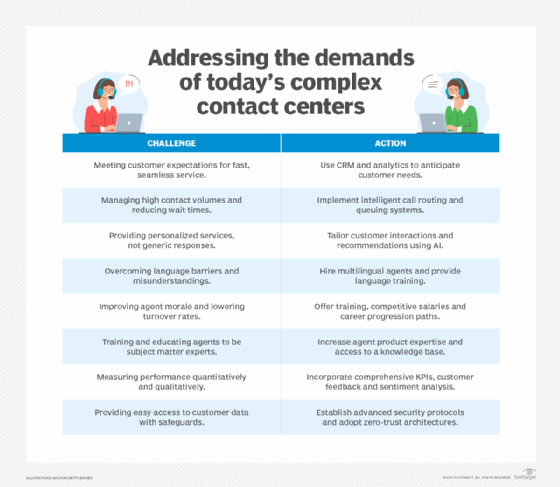Contact center outsourcing: What businesses need to know
Businesses use contact center outsourcing to alleviate agent understaffing, expand customer service and reduce costs, but loss of control and service inconsistency are concerns.
Most CX leaders can find themselves evaluating whether it makes sense to rely on outsourcing to handle the tasks of an internally run contact center or to invest in completely new service requirements.
In the business process outsourcing (BPO) model, companies partner with a third-party provider to handle back-end or front-office business processes, such as legal, accounting and customer service. Benefits include operational scalability, global coverage, increased service hours and expanded expertise. Contact center outsourcing has traditionally been the largest component (about one-third) of the $350 billion global BPO market.
Examples of outsourced contact center functions
Although some companies outsource all their contact center functionality, others are more selective and outsource only certain areas where they're deficient. Some companies outsource sales functions, but most typically keep sales internal, except for lead generation. Outsourcing delivers the most value in the areas of service, analytics and lead generation. Functions that companies outsource include customer service and support, telemarketing, monitoring social media, multilingual support and customer feedback programs.
External inbound customer service and support
Customer service and support is typically the top outsourcing function. Outsourcing is sometimes used as a backfill when volumes spike. It's also used during off-hours or for all customer service, including inbound customer calls to address product questions, warranty claims and complaints over any interaction channel.
Internal customer service and support
This function basically refers to employees and is typically used by large companies for HR and tech support over select channels, including voice, live chat and mobile chat.

Telemarketing
Numerous organizations are dedicated to generating leads for businesses via voice, email and social media. Though some businesses include outsourcing sales functions once a lead is generated, other companies prefer to respond to the leads using their own employees because of the value placed on each lead and the expertise of their own sales teams.
Social media monitoring
Considering all the social media sites and the potential for a viral post that can damage a company's reputation, it's no surprise social management is a top priority for CX leaders. The question is whether it's worth employing a team of people, along with the necessary technology, to monitor and manage social posts. For many companies, especially small businesses, the answer is no. They use a third-party partner to manage social media, which often extends to customer service and addressing any issue mentioned in a post.
Multilingual support
For global enterprises, the need to communicate with customers in their native language drives them to use an in-country outsourcing partner. With AI's rapidly improving language translation capabilities, this form of outsourcing, particularly for text messaging and web chat, is likely to decline among businesses that already operate an internal contact center.
Voice of customer programs
Some companies rely on their partners to gather feedback from their customers, analyze the response and make recommendations for improvement. Generative AI plays a role in scouring the web for open-ended comments on third-party sites, reading those comments and providing summary reports on qualitative customer responses.

Benefits of contact center outsourcing
Outsourcing delivers value to companies when they use it for the right reasons. Outsourcing is not a one-size-fits-all strategy, but it might alleviate headaches, reduce management overhead and lower technology investments, which could result in cost savings and a better focus on customer service. Metrigy's research shows the benefits of contact center outsourcing services in the following areas:
- Attrition. Given the tight job market and difficulty in finding qualified contact center agents, CX leaders no longer need to worry about understaffed contact centers because the outsourcer handles the staffing. Nearly two-thirds (64%) of companies are hiring more skilled agents in 2024, resulting in an ever-shrinking pool of agents, higher salaries and more turnover.
- Technology innovation. The fast pace of AI innovation in CX makes it expensive and time-consuming to keep up with the latest and greatest developments. Top contact center outsourcing organizations know technology is a key differentiator, so they typically invest in CX technologies at a higher rate (3.7% of their revenue) than all other industries (2.8%), according to Metrigy's "Customer Experience Optimization: 2023-24" global study of 641 companies.
- Expanded hours of coverage. Rather than spend resources on a 24/7 service staff, businesses can extend their hours of coverage by using an outsourcer when they don't have staff on the clock.
- More communication channels. Outsourcers typically offer coverage on all interaction channels, whereas a business might not want to invest in every social media channel, business messaging service or mobile capability.
- Better qualified agents and supervisors. Through the use of AI and automated coaching, outsourced agents often have access to training that businesses don't have in their own contact centers. What's more, supervisors can use generative AI reports that deliver detailed analysis of each agent's performance, giving them superior information to create more useful coaching sessions. These capabilities are available to any contact center, but they could be cost-prohibitive for smaller operations.

Challenges of contact center outsourcing
The most common roadblock is cost. CX and business leaders must do a detailed assessment of costs and ROI before investing in outsourcers. Depending on the size of the company and the specific customer service requirements, shared resources of outsourced contact centers can cost less, while dedicated resources will cost more. Management must determine if they want to absorb the cost of technology, management, staffing, equipment, real estate, benefits and more by running their own contact center.
More challenges can emerge with outsourcing. Will an outsourced team, for example, be as effective as one managed internally? Outsourcing results in a loss of control over nearly everything that's focused on customer service, including the people, technology, training and upsell. The third-party partner must be a trusted advisor that also benefits from successful customer service.
Outsourcing concerns also include language barriers, service consistency, cultural misalignment, rigid contracts with hidden fees and the lack of performance monitoring, according to Metrigy research. These issues must be carefully vetted by contact center management at the outset. The initial outsourcing contract should be short-term or contain exit clauses that enable the company to leave the relationship if issues can't be resolved.
How to manage an outsourced contact center
The most important factor in successful management of an outsourcing relationship is selecting the right outsourcer. That requires answers to key questions that address such issues as availability, communication style and service level agreements. Following are best practices for managing the outsourcer:
- Make sure the contract is crystal clear, defining all service levels and qualities, contingencies, and implementation times. Upfront detailed work on the contract can save hours later, especially during times of disagreement.
- Always identify an escalation path all the way up to the chief executives of both parties during times of disagreement, with cellphone numbers for all those involved.
- Ensure regular communications. As a partnership, daily, weekly, or at most, monthly communications, should be on everyone's calendars.
- Align the goals of the business and outsourcer by identifying the metrics to measure those goals and reviewing them regularly. As goals change, metrics will change, along with staff expertise, the hours required, agent scripts and the technology used.
- Offer incentives to align contact center performance with business success. If the outsourcer performs to certain metrics, for example, provide tiered revenue incentives.
As AI automates many contact center functions, it might make sense to keep certain functions in-house. But when businesses don't want to invest in technology or management, outsourcers can manage the AI functions as well.
Robin Gareiss is CEO and principal analyst at Metrigy, which conducts research and advises enterprises and technology providers.








